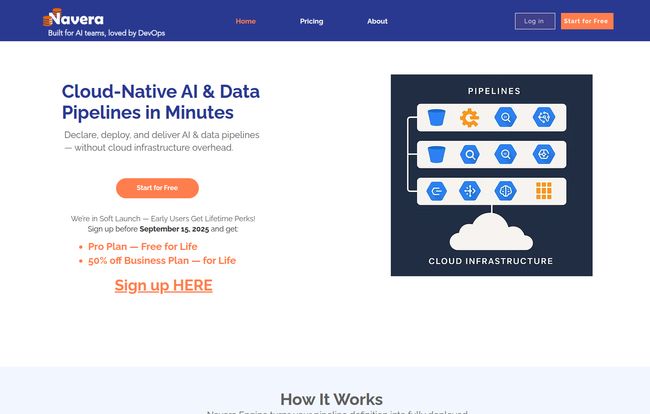We’ve all been there. Staring at a mountain of Terraform or CloudFormation, trying to stitch together a new data pipeline for the AI team. It’s a mess of modules, state files, secret management, and that one pesky IAM role that just refuses to cooperate. You spend days, sometimes weeks, getting it just right, and by the time you're done, the requirements have already changed. It’s the Groundhog Day of modern DevOps.
I've been in the cloud infrastructure game for a long time, and I've seen countless tools promise to solve this. Some help a little, some just add another layer of complexity. So, when I first heard about Navera and its pitch of “Cloud-native AI & Data Pipelines in Minutes,” my professional skepticism kicked in immediately. Minutes? Really? But my curiosity got the better of me. I had to see for myself.
So, What Exactly is Navera?
At its core, Navera isn't just another Infrastructure as Code (IaC) wrapper. It's an on-demand platform designed to take the soul-crushing boilerplate out of building and maintaining infrastructure for AI and data applications. Think of it as a smart abstraction layer that sits on top of your cloud provider. It’s less like building a car from scratch and more like using a high-end car configurator—you pick the features you want, and it figures out how to build the chassis, engine, and wiring harness for you.
It’s built for AI teams but, as the site says, “loved by DevOps.” And I can see why. It tries to bridge that classic divide where AI folks just want to run their models, and DevOps folks need security, reliability, and governance. Navera attempts to give both sides what they want. A bold move, for sure.

Visit Navera
The Navera Engine: How It Actually Works
Okay, the marketing sounds great, but how does it work in practice? The workflow is refreshingly simple, and this is where I started to get a little bit excited. It breaks down into three main steps:
- Declare Your Pipeline: This is the magic. You don’t start by writing HCL or YAML. Instead, you pick from a library of pre-configured templates or define your own pipeline declaratively. Want data to go from Google Cloud Storage, through a Dataflow job, and into BigQuery? You just... select that. You define the what, not the how.
- Deploy in Seconds: Once you’ve declared your pipeline, Navera takes over. It generates the necessary IaC (it uses Terraform under the hood, which is a big plus for trust), configures all the networking and permissions, and provisions the entire stack in your own cloud account. In one click.
- Deliver Results Faster: The pipeline is up and running. You can connect your data, run your models, and make changes without scheduling a two-week sprint with the platform team.
The fact that you can start with pre-built templates for everything from simple experiments to production-ready AI model training workflows is a massive accelerator. It lowers the barrier to entry for folks who aren't IaC wizards.
My Favorite Features (And a Few Quirks)
After playing around with it, a few things really stood out to me as genuinely useful, and a couple of things made me scratch my head.
The "DevOps-Approved" Peace of Mind
This was my biggest question going in. I’m not handing over control to some proprietary black box. The most reassuring part is that Navera is built on Terraform. It generates standard, auditable Terraform code. Better yet, you can actually export that code if you ever decide you want to manage it yourself or move away from the platform. That’s huge. It dramatically reduces the fear of vendor lock-in, which is a conversation I have with clients constantly.
Cost-Aware Pipelines are a Game-Changer
I once worked at a startup where an engineer left a test BigQuery stream running over the weekend and came back to a five-figure bill. Fun times. Navera’s focus on being “cost-aware” is more than just a buzzword. The platform is designed to give you visibility into the potential cost of teh infrastructure you're spinning up. In a world of spiraling cloud costs, building this awareness directly into the deployment workflow is just... smart. It's a feature that will make every CFO and FinOps manager breathe a sigh of relief.
A Couple of Head-scratchers
It’s not all perfect, of course. The platform is young. One thing I noticed is that the pricing for their “AI Fabric” product isn't on the main pricing page; you have to go hunting for it on the Google Cloud Marketplace. A minor inconvenience, but it breaks the flow. I also couldn't find any hard limits on the free tier's scalability. They say you get up to 500 resources, but what that means in practical terms for a complex pipeline is something you'll probably have to discover through good old-fashioned trial and error.
Let's Talk Money: Navera's Pricing Tiers
Pricing is always the elephant in the room. Navera has a pretty straightforward model that seems designed to let you grow into it. What's really interesting, though, is their current launch offer.
Here’s the breakdown, including the incredible deal they have running until September 15, 2025:
| Plan (Launch Offer Name) | Cost | Key Features |
|---|---|---|
| Free (Pro Plan for Life Offer) | $0 | Up to 500 resources per month. No credit card required. If you sign up before the deadline, you get this Pro plan for life. |
| Standard (Business Plan Offer) | $0.37 /month/resource | Unlimited resources, customer support. Sign up before the deadline for 50% off for life. |
| Enterprise | Custom | Includes cloud consultancy and private hosting options. |
That launch deal is pretty wild. A free-for-life pro plan is a no-brainer for anyone wanting to try it out without pressure. The resource-based pricing of the Standard plan is fair, as it scales with your actual usage.
Who is Navera Actually For?
After my deep dive, I can see a few groups getting a ton of value here.
- AI Engineers & Data Scientists: This is the most obvious one. These folks can finally get some autonomy. They can spin up the exact infrastructure they need for an experiment without filing a Jira ticket and waiting two weeks. It's about self-service and speed.
- DevOps & Platform Engineers: Instead of being reactive pipeline builders, they can become enablers. They can set the guardrails and then offer Navera as a standardized, secure, self-service platform to their internal customers. Less firefighting, more strategic work.
- Startups & Small Teams: If you don't have a dedicated platform engineering team, this could be your platform team in a box. It lets you punch above your weight, deploying production-grade, scalable infrastructure from day one.
The Final Verdict: Is Navera Worth Your Time?
So, do I think Navera is the future? It’s a strong contender for a piece of it. It’s not going to replace the hardcore infrastructure engineer who loves handcrafting every line of HCL. And that’s fine. It’s not for them.
It’s for the 90% of other teams who value speed, developer empowerment, and standardization over bespoke, artisanal infrastructure. It's for organizations that want their expensive AI talent to spend more time building models and less time wrestling with YAML.
In my opinion, Navera is a powerful step in the right direction for the industry. It's a smart abstraction that doesn't completely hide what's going on, and its focus on real-world problems like cost and security is exactly what's needed. With the ridiculously generous free tier and launch offer, there's literally no reason not to give it a spin.
Frequently Asked Questions
- Do I need to know Terraform or YAML to use Navera?
- Nope! That's one of the main attractions. You define your pipeline at a higher level, and Navera generates the underlying Terraform and YAML for you. You don't have to touch it unless you want to.
- What cloud providers does Navera support?
- Currently, it's focused on Google Cloud Platform (GCP). According to their site, support for AWS and Azure is on the roadmap and coming soon.
- Can I ever leave Navera if I wanted to?
- Yes. Because Navera generates standard Terraform code, you can export your configurations and manage them yourself at any time. This is a key feature that helps avoid vendor lock-in.
- Where does the infrastructure actually get deployed?
- This is important: it deploys directly into your own cloud account. Navera doesn't host your infrastructure; it just orchestrates its creation within your environment, which is great for security and data privacy.
- Is it possible for my team to collaborate on pipelines?
- Yes, the platform is built for teams. On the Business and Enterprise plans, you can manage users, assign roles, and track shared usage across different projects.
Conclusion
The world of cloud infrastructure is complicated enough. Tools that bring elegant simplicity to complex problems will always get my attention. Navera does just that. By focusing on the declarative outcome rather than the procedural steps, it frees up brilliant people to do their best work. It's a promising platform that solves a very real, very expensive problem for a lot of companies. I’m definitely keeping my eye on them.



